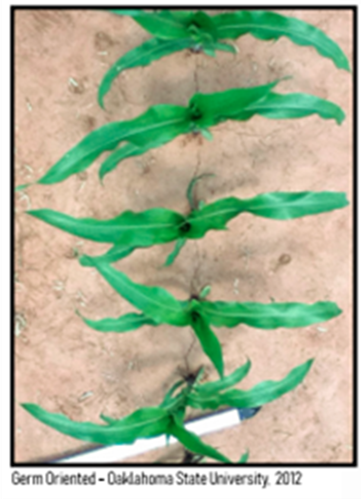2023 PAR (Product & Agronomy Research) Report: Seed Positioning and Orientation Study
BY Dairyland Seed Agronomy Team
Recent industry research spurred interest in the orientation of corn seed when it is planted. Demonstrations and preliminary observations by Bob Shultz at our Wabash PAR location indicate promising possibilities.
This concept is not totally new. Researchers have been investigating this idea for several years. What is more recent is the ability to do so on a field scale basis. Dairyland Seed agronomists and field staff hand planted three demonstration sites: Mount Hope, WI; Lafayette, MN; and Wabash, IN. Those who attended the local field events could see this concept firsthand. With advances in technology, there now exist planters with the ability to orient seed within the row. Why is there interest in the direction a seed is planted? The position of the seed kernel and the germ side of the seed can influence the ultimate leaf orientation in the row. This can have a possible impact on light capture and yield.
There is also evidence that seed orientation could improve emergence as well. Planter technology companies are investigating the possibility of positioning seeds tip down and orienting in furrow. MK1 Engineering is one company working on this planting technology AeroTube.
For additional information, visit their website https://mk1eng.com/.
TREATMENT
1. Check random drop
2. Tip down, germ facing with row
3. Tip down, germ facing out of row

FIGURE 1: GERM ORIENTATION - OKLAHOMA STATE UNIVERSITY, 2012
RESULTS
TABLE 1: 2023 SEED ORIENTATION STUDY RESULTS

CONCLUSION
A review of research on this planting concept showed that yield increased 9% to as much 20%.
The studies referenced for planting seed tip down and seed germ oriented to center are Illinois State University, 2013 => 14% - 19%; Oklahoma State University, 2012 => 09% - 14%; Journal of Production Ag, 1999 => 10% - 20%. The ISU research data will be referenced below.1
Additional research related to emergence would indicate an advantage toward seed orientation tip down. In 1970, two researchers, G. P. Pattern and D. M. VanDoren Jr., found that in a controlled laboratory environment “will give earlier, more complete emergence with greater more rapid seedling growth” and “is better able to overcome environmental deterrents to emergence and growth.2
Based the information collected, it would appear as technology progresses, we could see precise seed placement and orientation be positive driver to increasing yields in the near future.
1 Kaufman, Tyler D., “The Effects of Planting Techniques on Maize Grain Yield and Silage Production” (2013). Theses and Dissertations.
49.https://ir.library.illinoisstate.edu/etd/49
2 G. P. Pattern and D. M. VanDoren Jr., “Effect of Seed Orientation on Emergence and Growth of Corn” Ohio Agricultural Research and
Development Center, Wooster, Ohio, as Journal Article No. 43-70. (1970)

Brian Weller
Western Region
507.456.3034

Rod Moran
Western Region
507.456.3034

Dan Ritter
Central Region
219.863.0583

Branden Furseth
Northern Region
608.513.4265

Mark Gibson
Eastern Region
260.330.8968

Amanda Goffnett
Eastern Region
989.400.3793

Ryan Mueller
Eastern Region
989.400.3793
